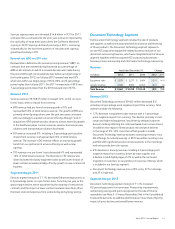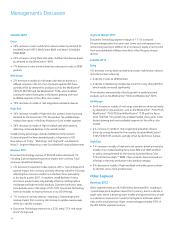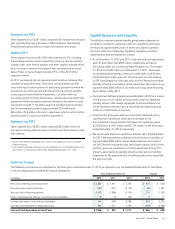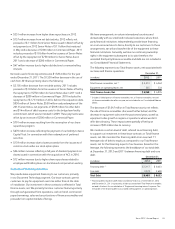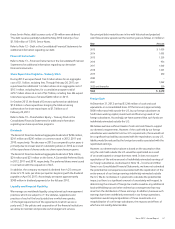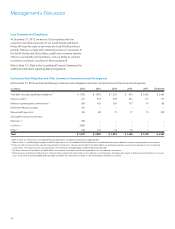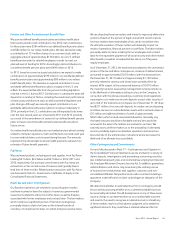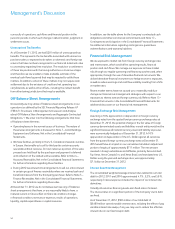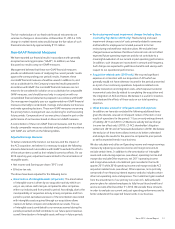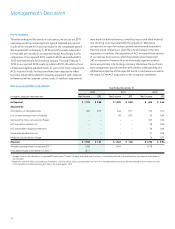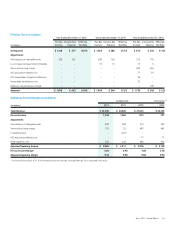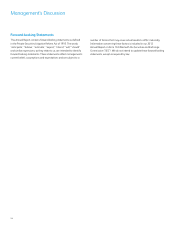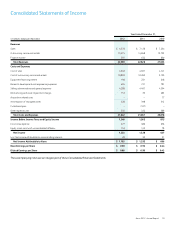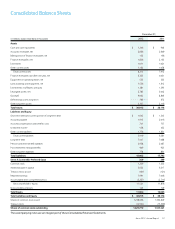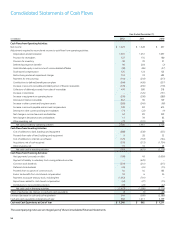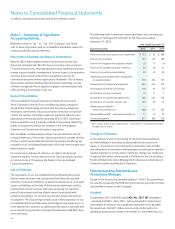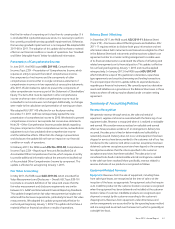Xerox 2012 Annual Report Download - page 53
Download and view the complete annual report
Please find page 53 of the 2012 Xerox annual report below. You can navigate through the pages in the report by either clicking on the pages listed below, or by using the keyword search tool below to find specific information within the annual report.51Xerox 2012 Annual Report
The fair market values of our fixed-rate financial instruments are
sensitive to changes in interest rates. At December 31, 2012, a 10%
change in market interest rates would change the fair values of such
financial instruments by approximately $113 million.
Non-GAAP Financial Measures
We have reported our financial results in accordance with generally
accepted accounting principles (“GAAP”). In addition, we have
discussed our results using non-GAAP measures.
Management believes that these non-GAAP financial measures
provide an additional means of analyzing the current periods’ results
against the corresponding prior periods’ results. However, these
non-GAAP financial measures should be viewed in addition to, and
not as a substitute for, the Company’s reported results prepared in
accordance with GAAP. Our non-GAAP financial measures are not
meant to be considered in isolation or as a substitute for comparable
GAAP measures, and should be read only in conjunction with our
consolidated financial statements prepared in accordance with GAAP.
Our management regularly uses our supplemental non-GAAP financial
measures internally to understand, manage and evaluate our business
and make operating decisions. These non-GAAP measures are among
the primary factors management uses in planning for and forecasting
future periods. Compensation of our executives is based in part on the
performance of our business based on these non-GAAP measures.
A reconciliation of these non-GAAP financial measures, and the most
directly comparable measures calculated and presented in accordance
with GAAP, are set forth on the following tables.
Adjusted Earnings Measures
To better understand the trends in our business and the impact of
the ACS acquisition, we believe it is necessary to adjust the following
amounts determined in accordance with GAAP to exclude the effects
of the certain items as well as their related income tax effects. For our
2012 reporting year, adjustments were limited to the amortization of
intangible assets:
• Net income and Earnings per share (“EPS”), and
• Effective tax rate.
The above have been adjusted for the following items:
• Amortization of intangible assets (all periods): The amortization
of intangible assets is driven by our acquisition activity which can
vary in size, nature and timing as compared to other companies
within our industry and from period to period. Accordingly, due to the
incomparability of acquisition activity among companies and from
period to period, we believe exclusion of the amortization associated
with intangible assets acquired through our acquisitions allows
investors to better compare and understand our results. The use
of intangible assets contributed to our revenues earned during the
periods presented and will contribute to our future period revenues
as well. Amortization of intangible assets will recur in future periods.
• Restructuring and asset impairment charges (including those
incurred by Fuji Xerox) (2010 only): Restructuring and asset
impairment charges consist of costs primarily related to severance
and benefits for employees terminated pursuant to formal
restructuring and workforce reduction plans. We exclude these
charges because we believe that these historical costs do not reflect
expected future operating expenses and do not contribute to a
meaningful evaluation of our current or past operating performance.
In addition, such charges are inconsistent in amount and frequency.
Such charges are expected to yield future benefits and savings with
respect to our operational performance.
• Acquisition-related costs (2010 only): We incurred significant
expenses in connection with our acquisition of ACS which we
generally would not have otherwise incurred in the periods presented
as a part of our continuing operations. Acquisition-related costs
include transaction and integration costs, which represent external
incremental costs directly related to completing the acquisition and
the integration of ACS and Xerox. We believe it is useful for investors
to understand the effects of these costs on our total operating
expenses.
• Other discrete, unusual or infrequent costs and expenses:
In addition, we have also excluded the following additional items
given the discrete, unusual or infrequent nature of the item on our
results of operations for the period: (1) Loss on early extinguishment
of liability (2011 and 2010), (2) Medicare subsidy tax law change
(income tax effect only) (2010), (3) ACS shareholder’s litigation
settlement (2010) and (4) Venezuela devaluation (2010). We believe
the exclusion of these items allows investors to better understand
and analyze the results for the period as compared to prior periods
as well as expected trends in our business.
We also calculate and utilize an Operating income and margin earnings
measure by adjusting our pre-tax income and margin amounts to
exclude certain items. In addition to the amortization of intangible
assets and restructuring expenses (see above), operating income and
margin also exclude Other expenses, net. 2011 operating income
and margin also exclude a Curtailment gain recorded in the fourth
quarter 2011 while 2010 operating income and margin exclude ACS
acquisition related costs (see above). Other expenses, net is primarily
comprised of non-financing interest expense and also includes certain
other non-operating costs and expenses. The Curtailment gain resulted
from the amendment of our primary non-union U.S. defined benefit
pension plans for salaried employees to fully freeze future benefit and
service accruals after December 31, 2012. We exclude these amounts
in order to evaluate our current and past operating performance and to
better understand the expected future trends in our business.


